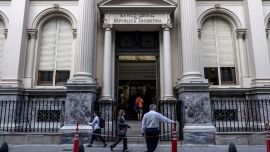Everyone knew the International Monetary Fund’s projections about the speed of Argentina’s recovery after agreeing to bail-out the beleaguered nation with a record US$56-billion loan were unrealistic. They were as much of a fiction as the projections underlying the 2018 Budget passed by the Mauricio Macri administration in late 2017, which hours after passing the legislation through both chambers of Congress decided to tell the Central Bank, then led by Federico Sturzenegger, to abandon inflation targeting, effectively raising expectations about what it had just committed itself to before the Legislature.
While no-one could’ve predicted the magnitude of the Argentine economic meltdown, it was clear that a quick recovery was highly improbable. Still, the structural programme that accompanied the IMF’s loan – supposedly put together by technical teams responding to both the Fund and Argentina’s then-economy minister Nicolás Dujovne – prescribed tough austerity on both the fiscal and monetary fronts. One could argue there was no alternative, as in Macri’s first two years in office the fiscal expansion worsened the deficit, while monetary contraction sought to tackle inflation ineffectively. Once international debt financing dried up, the market took care of the correction Macri was unable to execute. It is clear now that the IMF and Macri’s economic team are directly responsible for what has happened since.
The current state of Argentina’s economy is perilous. The typical metaphor is that of a ticking time-bomb, the same one that was used when Macri took over the reins from Cristina Fernández de Kirchner.
In charge of the Economy Ministry now is Martín Guzmán, an anti-austerity economist who cut his teeth under Nobel laureate Joseph Stiglitz at the prestigious Columbia University in New York. Quoted by the Financial Times, Stiglitz praises Guzmán thusly: “The thing about Martín is that he is terrific at mathematical models and high theory [of the sort that orthodox economists and markets love] but he’s also interested in changing things in the real world.” While Stigtlitz is taking a stab at his orthodox colleagues, what he’s indicating is that Guzmán is a skilled economist from a theoretical standpoint. His Argentine mentor, economist Daniel Heymann of the Universidad Nacional de la Plata, told Noticias magazine Guzmán is “valuable” and “pragmatic.” On Thursday, Guzmán was named chair of the Currency, Credit, and Banks department of that university, replacing Heymann.
While Guzmán’s economic plan isn’t entirely clear yet, initial signs of moderation have pleased the market. In his first major public address as economy minister this week, Guzmán spoke of “macroeconomic consistency” while making it clear that the policy framework his team plans to put in place has the intention of stabilising the economy. Probably his most important message was that there is no margin for fiscal stimulus, and that the use of the printing press to jumpstart the economy would be “destabilising.” While this appears to be a message aimed at foreign creditors in the context of the coming debt restructuring (which will be the key to his success or failure in the hot seat that is the Economy Ministry) it is a welcome statement given pressure from different segments to rely on monetary expansion in the current context where Argentina is effectively locked out of international markets, over indebted and still in situation of fiscal deficit.
The contours of the plan are beginning to come into view. Guzmán – along with Matías Kulfas at the Production Ministry, Miguel Ángel Pesce at the Central Bank, and the rest of the related official entities – will look to provide relief to the lower sectors of society, at the expense of the agricultural sector and overall higher taxes on personal wealth. Currency controls will be tightened, with taxes aimed at disincentivising dollar-denominated consumption and savings, while export taxes will be raised. Along with Alberto Fernández’s “Social Solidarity and Productive Activation” Law, the idea is to freeze public service costs for 180 days, while ordaining increases in pension payments and private sector salaries by decree.
There’s more to the plan, but the basic idea is that through a “social pact” that includes the major economic and political actors, price increases will be contained while real wages should rise above inflation, therefore aiming at producing a consumption shock that should drag the economy out of recession. This will be financed to a small degree by monetary expansion, by higher taxes on specific sectors (which, by definition, reduces output), and should all happen in the context of a move toward fiscal balance and a trade surplus due to a competitive peso-dollar exchange rate. There is a clear break with the IMF’s orthodoxy, and Macri’s obsession with fiscal surplus. A Keynesian wink of sorts.
It isn’t entirely clear how Argentina will improve its productivity, therefore generating the conditions for a competitive export sector that produces enough dollars to break the eternal vicious cycle that has destroyed our national currency. Yet, it is the first time in a while that there is a plan on the table. And the feeling of security and predictability of actually having a plan, something Guzmán indicated he will put down on paper, has sent positive signs to the market.
Guzmán became a known name in Argentina a few months before Fernández’s electoral victory, mainly as a sovereign debt restructuring specialist. “Restoring debt sustainability is a necessary condition for economic recovery. Economic recovery is a necessary condition for restoring debt sustainability,” he explained in a recent presentation, in which he argued for a two-year moratorium on debt payments, the rejection of any additional IMF money, and a successful negotiation with creditors that avoids a default and should be concluded by March 2020. He also wants a “convergence to primary fiscal surpluses and trade balance consistent with sustainable reprofiled debt at a speed that does not create destabilising macroeconomic effects.”
Austerity, as a general remedy to a public debt crises, does not work. Half of the countries that went through a sovereign debt restructuring with private creditors were forced to default or restructure again within three years, Guzmán argued, noting that only Ireland in 1987 successfully came out of a default through austerity. Why? Its main trading partner was experiencing an economic boom at the time. Without the stroke of good luck, nations are set on a path to more distress and the constant risk of default. The memory of Greece is all too fresh, a nation which lost 25 percent of its GDP from 2007 to 2013 in the context of a series of IMF bailouts and structural austerity programmes.
It is unclear if the social pact that Fernández and his team are looking to introduce will succeed in rooting inflationary momentum and activating the economy. Yet, the rejection of austerity as the only way out of Argentina’s crisis, which appears to be Guzmán’s main contribution, seems like the right way out of this mess. And, the idea of macreconomic coherence, in particular given the fiscal deficit and the size of the debt pile, gives the rejection of austerity a logical framework. Now, it’s time to see if the economist can put his theoretical toolbox to work on the real economy.




















Comments